Proper lubrication greatly increases the life of bearings, especially in adverse conditions. Therefore, it is important to apply the correct lubrication practices to prevent premature bearing failure.
In this guide is the endorsed instructions for tapered roller bearing lubrication. But before we delve into that, let's take a quick look at the overview of tapered roller bearings.
Tapered Roller Bearings
Tapered roller bearing assemblies are precisely designed to manage both radial and axial loads, even in the most extreme conditions.
Each tapered roller bearing contains four interdependent components: the cone (inner ring), the cup (outer ring), tapered rollers (rolling elements) and the cage (roller retainer). Tapered angles allow our bearings to efficiently control a combination of radial and thrust loads. The steeper the outer ring angle, the greater ability the bearing has to handle thrust loads. To provide a true rolling motion of the rollers on the raceways, the extensions of the raceways and the tapered surfaces of the rollers come together at a common point, the apex, on the axis of rotation.
There are a few main types of tapered roller bearings, namely:
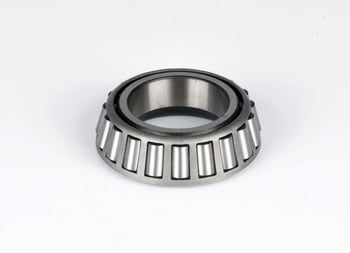
This is the basic and the most widely used type of tapered roller bearing. It consists of the inner-ring assembly and the outer ring. It is usually fitted as one of an opposing pair. During equipment assembly, single-row bearings can be “set” to the required clearance (endplay) or preload condition to optimize performance.
Single-row bearings are used in a wide range of applications, such as:
- Gear boxes, pumps and conveyors used in power gen, mining, oil and gas, wind energy, pulp and paper, food and beverage, gear drives, cement and metals applications.
- Drive trains, gear drives, axle centers, wheel ends and transmissions used in construction, mining, rail, automotive and commercial vehicles.
2) Double-Row Bearings (TDO - DOUBLE OUTER RING)
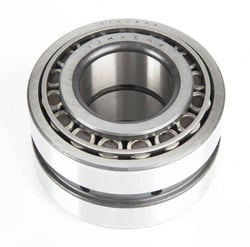
This type of bearing has a one-piece (double) outer ring and two single inner rings. It is usually supplied complete with an inner-ring spacer as a pre-set assembly. This configuration gives a wide effective bearing spread and is frequently chosen for applications where overturning moments are a significant load component. TDO bearings can be used in fixed (locating) positions or allowed to float in the housing bore, for example, to compensate for shaft expansion.
Applications of TDO bearings include heavy-duty gear drives and various industrial configurations.
3) Double-Row Bearings (TDI - DOUBLE INNER RING)
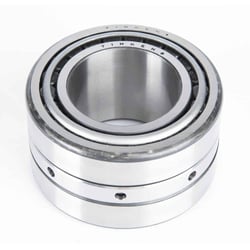
This comprises a one-piece (double) inner ring and two single outer rings. They are usually supplied complete with an outer ring spacer as a pre-set assembly. TDI bearings can be used at fixed (locating) positions on rotating shaft applications. For rotating housing applications, the double inner ring of type TDI can be used to float on the stationary shaft.
TDI bearings are used in applications such as gear reduction units, cranes calendar rolls and industrial machinery.
Best Practice: Packing a Tapered Roller Bearings with Grease
Applying the right bearing lubrication is one of the best practices that can help increase bearings lifespan and enhance bearings performance. The following guide provides a quick and easy way to pack your tapered roller bearings with grease.
There are two methods to apply grease to the bearing, either by hand or using a mechanical grease packer.
| Warning: |
| Never spin a bearing with compressed air. The components may be forcefully expelled. |
| Proper maintenance and handling practices are critical. |
| Always follow installation instructions and maintain proper lubrication. |
| A bearing/component should not be put into service if its shelf life has been exceeded. |
Method 1: By Hand
1. Thoroughly clean your hands or wear a new pair of latex gloves.
2. Place a golf-ball sized amount of grease into your palm.
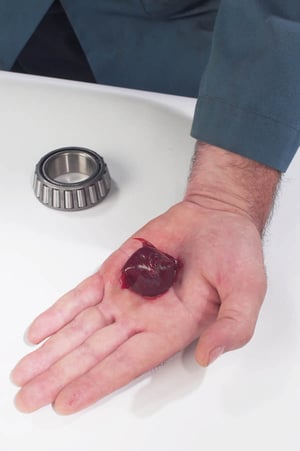
3. Using your opposite hand, push the large end of the bearing cone assembly into the grease, forcing grease between the rollers, cage and cone.

4. While pushing grease into the large end, rotate the entire cone assembly until the grease is forced out evenly around the entire small end.
5. Smear excess grease on the outside of the bearing cone assembly.
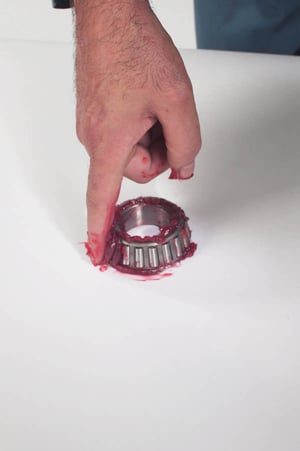
Method 2: Using a Mechanical Grease Packer
1. Thoroughly clean your hands or wear a new pair of latex gloves.
2. Place the bearing cone assembly, small end down, into the grease packer funnel.
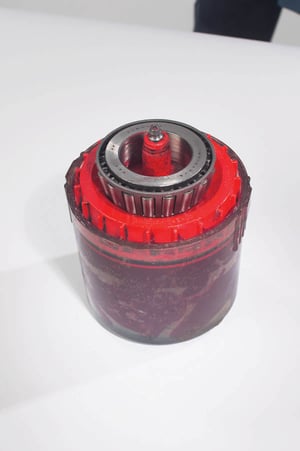
3. Plug the bore of the large end of the bearing cone assembly with the conical retainer.
4. Firmly press down on the conical retainer. This forces the grease between the rollers, cage and cone.

5. Smear excess grease on the outside of the bearing cone assembly.

| Take Note: |
| You should allow enough space in the housing for heat dissipation so excess grease throws clear from the bearing. Contain the grease around the bearing. The housing should normally be 1/3 to 1/2 full of grease during bearing assembly. Too much grease in the housing may cause high temperatures and excess churning of the grease. |
You can also watch the video version of the guide here:
Want to know more about bearing maintenance best practices?
Bearing maintenance is an essential process to keep your bearings to achieve peak performance and a long life. If you would like to know more about bearing maintenance best practices, please get in touch with us below:
 The Timken Company (NYSE: TKR; www.timken.com) designs a growing portfolio of engineered bearings and power transmission products. With more than a century of knowledge and innovation, we continuously improve the reliability and efficiency of global machinery and equipment to move the world forward. Timken posted $3.5 billion in sales in 2020 and employs more than 17,000 people globally, operating from 42 countries.
The Timken Company (NYSE: TKR; www.timken.com) designs a growing portfolio of engineered bearings and power transmission products. With more than a century of knowledge and innovation, we continuously improve the reliability and efficiency of global machinery and equipment to move the world forward. Timken posted $3.5 billion in sales in 2020 and employs more than 17,000 people globally, operating from 42 countries.
**All images were derived from Timken







